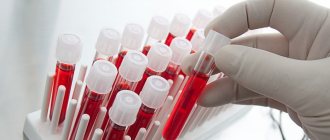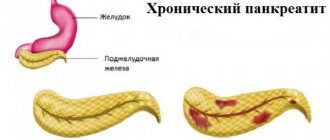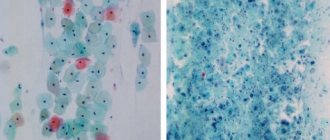Author
: Grachev Ilya Illarionovich
Editor
: Efremov Mikhail Mikhailovich
Publication date: 05/13/2014 Update date: 12/16/2021
Muscle pain, which can either intensify during movements or touches, or torment a person constantly, even at rest, is a reason to think about your health. Myalgia is the name of this common disease, and both older people and children suffer from it.
A large number of people around the world suffer from this disease, which negatively affects the quality of life, disrupting their usual routine. Myalgia is a disease that requires accuracy in diagnosis and correct, individual treatment. It has many manifestations and a variety of factors can trigger its development.
Myalgia does not go away on its own and has serious complications, so you should not delay treatment.
See how easily the disease can be cured in 10-12 sessions.
General information
Myalgia - what is it? Myalgia is a syndrome manifested by spontaneous muscle pain during physical stress/rest or caused by external influences (active/passive movements in the joints, palpation). Muscle pain can be either local, for example in the thigh muscle of the leg, or diffuse (muscle pain throughout the body). Myalgia is often accompanied by joint pain ( arthralgia ).
Functional muscle diseases, occurring with pain of varying severity, can occur in healthy people after unusual (hard) physical work or often in athletes during overtraining. In such cases, there may be compaction of the muscles that have been overloaded and their moderate swelling. Myalgia can develop after injuries, or sharp pain can appear with convulsive contraction of certain muscle groups, for example, in the calf muscle when walking with intermittent claudication. Pain in the muscles of the legs, neck and back is especially common.
At the same time, myalgia can also be one of the manifestations of a number of diseases ( polymyalgia rheumatica , infectious diseases, vascular pathology, diseases of the joints and visceral organs, etc.), autoimmune pathologies, or caused by the action of toxic/medicinal substances. Myalgia ranks second in prevalence, second only to headaches, and over 48% of all pain syndromes are of muscular origin. As a rule, with a minor muscle injury/physical overload of the muscles, the pain syndrome regresses spontaneously within 2 days, however, in some cases, myalgic syndrome persists with the threat of developing chronic myofascial pain syndrome (MPS), in which fascia and tendons are involved in the process of formation of persistent pain in addition to muscles . The syndrome is often characterized by chronic muscle dysfunction (muscle stiffness and localized pain).
Since pain is not a specific nosological form, objectively interpreting myalgic syndrome in clinical practice with determining its nosological affiliation is a rather difficult task, since it is characteristic of various infectious, neurological, endocrinological and systemic rheumatic diseases and has similar clinical manifestations with them.
Injuries
Severe pain can occur when muscle fibers and tendons are torn. This usually happens if the load is excessive and the muscles are not prepared for it1. But they can also be damaged by sudden movements3. Unlike “ache” due to muscle overwork, pain due to injury occurs immediately, at the peak of the load3.
It should be remembered that even a small, but untreated injury can cause an even more severe sprain3. Therefore, if you experience pain during physical activity, be sure to consult a doctor to rule out a serious injury.
to come back to the beginning
Classification
The classification is based on various criteria, according to which the following are distinguished:
- According to pathological changes in the muscular-ligamentous apparatus: fibromyalgia (primary/secondary), myositis (polymyositis), epidemic myalgia .
- According to the nature of the course: acute, chronic.
- According to the location of pain: localized, diffuse.
- According to the level of the CPK enzyme (creatine phosphokinase) in the blood: with an increase in CPK activity and without a change in the level of CPK.
Treatment of muscle pain in the legs using UVT
Extracorporeal shock wave therapy (SWT) is a method that emerged from lithotripsy, a method of crushing gallstones and kidney stones, and immediately gained wide popularity. For UVT, a special device is used that generates an infrasonic wave. The sound wave, penetrating deep into the tissues of the affected area of the body, activates regeneration processes, increases blood flow - blood microcirculation, and increases the permeability of cell membranes. UVT also has anti-inflammatory and anti-edematous effects.
The advantage of this treatment method is that there is no need for hospitalization. ShT is prescribed only on an outpatient basis, the course of treatment is usually 5-7 sessions of 10-15 minutes each. SWT, as a non-surgical method, does not have any side effects that can be observed with surgical intervention. Contraindications for prescribing UVT are malignant tumors, pregnancy and some cardiac diseases.
Causes of myalgia
Myalgia can be a consequence of a number of reasons, the main of which are:
- Injuries (domestic, sports, industrial) with damage to one or another muscle group, causing sharp muscle pain, for example, sharp pain in the calf muscle when jumping high.
- Physical overload (overwork). They are typical for athletes, but often occur in everyday life after unusual heavy physical work, in which the load falls on muscles that are usually little used.
- Long-term static loads (staying in one position).
- Hypothermia, especially being in a draft.
- Severe stress with emotional breakdowns.
- Long-term use of certain medications ( penicillins , Diazepam , L-tryptophan , calcium gluconate , clofibrate , Nifedipine , clonidine , statins , etc.).
- Infectious/parasitic diseases ( neuroinfections , influenza , trichinosis , cysticercosis , toxoplasmosis ).
- Vascular diseases ( atherosclerosis ) are common causes of pain in the calf muscles, for example with intermittent claudication.
- Metabolic disorders ( diabetes , amyloidosis , glycogenosis , etc.).
- Rheumatic diseases, such as periarteritis nodosa , systemic lupus erythematosus , rheumatoid arthritis , scleroderma , polymyalgia rheumatica , which cause muscle pain throughout the body.
- Intoxication (lead, alcohol, carbon monoxide).
- Lack of potassium/calcium in the body.
- Dermatomyositis / polymyositis .
- Osteochondrosis.
Diseases of the spine and joints
Muscles react to disruption of the joints4 and vertebrae5 associated with them. Therefore, myalgia is one of the symptoms of diseases of the spine5,11 and joints of the limbs4. For example, with osteochondrosis or scoliosis (curvature of the spine), pain in the neck, chest or lower back is associated with overstrain of the paravertebral muscles5,11. And in advanced cases, when the vertebra compresses the nerve root emerging from the spinal cord, the pain can “radiate” to the arm or leg11.
Often myalgia with osteochondrosis is combined with a feeling of numbness or “crawling goosebumps”. At the moment of acute pain, a person freezes, taking a forced position11.
Symptoms of myalgia
The main manifestation of myalgia (fibromyalgia), myositis, myofascial syndrome is pain of varying severity and localization. The pain can be constant at rest or intensify with palpation of the muscle or during movement (especially when walking). In addition to pain, symptoms of the disease may include muscle tension and joint stiffness, headache , and fever. Symptoms of myalgia can vary significantly depending on the type of myalgia.
Fibromyalgia . It is characterized by diffuse muscle pain in often symmetrical specific areas of the body, or the pain can be diffuse in nature when patients complain of pain throughout the body. In addition to muscle pain, patients experience the following symptoms: increased fatigue, depressive disorders , insomnia , anxiety , and weather dependence . The pain may intensify due to increased stress, under the influence of dampness/cold. The pain syndrome is most often localized in the occipital, cervical, lumbar and shoulder regions, and with diffuse pain syndrome in certain areas of the trunk or lower extremities (in the leg muscles above the knee or pain in the calf muscle).
Myofascial syndrome . It is characterized by a pronounced chronic muscle pain syndrome and the formation of specific painful compactions in the muscles, the so-called trigger points, which mean an area of hyperirritability localized in a compacted muscle cord or fascia, the irritation of which is manifested by local and referred pain in an area that is remote from such a point. That is, when pressing on the TT, acute local pain appears, accompanied by shuddering, as well as pain that radiates to a distant, strictly defined area (referred pain). Under favorable conditions, TT can regress on its own within 3-5 days, but under unfavorable conditions (muscle stress, hypothermia), the duration of the disease can last up to a year. In addition to pain, there may be a limitation in range of motion, impaired sensitivity, and, less commonly, autonomic dysfunction. Referred pain from certain active myofascial trigger points has its own distribution pattern.
Myositis/polymyositis . Myalgia of inflammatory origin in most cases is a complication of various diseases. Myositis usually affects a specific muscle group, and in the presence of many foci of inflammation we are talking about polymyositis. Often the process involves not only muscle tissue, but also the skin (dermatomyositis). The leading symptom of acute myositis is severe pain in a certain muscle group (lower leg, neck, lower back, chest), which intensifies during movement, when pressing on the area of the affected muscles, or when the weather changes. In chronic myositis, the nature of the pain is predominantly aching and there is constant muscle weakness. Swelling and redness of the skin at the site of inflammation is less common. Due to the protective reaction of the muscles, the work of the joints is limited with the frequent development of arthritis . Polymyositis is characterized by general muscle weakness, which often leads to muscle atrophy. The patient complains that it is difficult for him to raise his head, stand up, or take something in his hand.
Exercise stress
“Body aches” after physical activity can occur both in untrained people and in professional athletes8. And the cause of discomfort is the accumulation of under-oxidized metabolic products in muscle cells; in particular, painful sensations are caused by an excessive amount of lactic acid (lactate)2. Less commonly, the cause is microtrauma, but this can only occur if the training rules are violated8.
Muscle soreness due to overwork does not occur immediately, but after a few hours or within 1-2 days after training or unusual physical activity and disappears within a week8.
List of sources
- Shostak N. A., Pravdyuk N. G., Novikov I. V., . Trofimov E. S. Myalgia in therapeutic practice – approaches to differential diagnosis, treatment // Attending physician. No. 3 p. 21-24.
- Ivanichev G.A. Pathogenetic aspects of the formation and manifestation of classical muscle pain syndromes. Manual therapy. 2009; 3 (35): 3–12.
- Busheneva S.N., Kadykov A.S., Piradov M.A. Myofascial syndrome: from theory to practice. Russian medical journal. 2005; 22. p. 57-62.
- Godzenko A.A., Badokin V.V. Local therapy of myofascial pain syndrome. RMJ. Rheumatology. 2007; 26: 1998–2003.
- Osipova N. A., Abuzarova G. R., Petrova V. V. Principles of using analgesics for acute and chronic pain. Clinical recommendations. M.: FSBI “MNIOI im. P. A. Herzen” Ministry of Health and Social Development of Russia, 2010. 67 p.
MYASTHENIAS
A disease of the autoimmune system that causes muscle weakness due to interruptions in neuromuscular transmission is called myasthenia gravis. The activity of the ocular, facial and masticatory muscles is usually impaired; the muscles of the respiratory organs are less commonly affected. Characteristic manifestations: drooping of the lower eyelid, disturbances in vocal function (nasal sound, hoarseness, hoarseness or weakness), disturbances in swallowing and chewing.
The word "myasthenia" means impotence, muscle weakness. This is a pathological process, which is based on the self-destruction of body cells. The normal immune response changes direction and begins to destroy its own cells instead of foreign ones, which leads to the destruction of organs and tissues of the body.
Possible reasons:
- genetic predisposition;
- benign or malignant tumors;
- systemic diseases;
- damage to the nervous system;
- hyperthyroidism, sleeping sickness.
DIAGNOSTICS
Diagnosis of diseases can only be carried out by a doctor at a medical center. It begins with a detailed questioning of the patient: the nature of the pain, its intensity, location, and factors that intensify it are clarified. The doctor palpates (feels) the affected muscles, noting increased sensations, tightness, and the presence of swelling. Then it is assigned:
- collection of blood tests (general and biochemistry), urine;
- electromyogram, ultrasound, CT, radiography, MRI;
- If necessary, the doctor may prescribe an ECG and muscle tissue biopsy.
Contacting a qualified specialist will help protect yourself from making an incorrect diagnosis, since the pain that appears can be indistinguishable from other diseases. For example, pain in the lumbar region with myositis may be indistinguishable from kidney disease or similar to a vertebral hernia or osteochondrosis. An advanced disease will be very difficult to cure.
Rhabdomyolysis
With muscle injuries (more common in athletes), gradual destruction of tissue occurs, this condition is called rhabdomyolysis. This process ultimately ends with the death (necrosis) of cells and the release of toxins into the circulatory system. This disease can cause serious complications and lead to kidney failure. If qualified assistance is not provided, it can result in death.
Possible reasons:
1. Bodily injuries (injuries, beatings, accidents, accidents).
2. Stage 3 and 4 burns.
3. Long surgical operations (more than 8–10 hours).
4. Long-term compression of tissues with impaired blood supply.
5. Electric shocks.
The development can be provoked by: increased loads during training, epileptic seizures, severe muscle spasms, delirium tremens.
It is very difficult to recognize the disease; the manifestations are similar to the symptoms of many diseases; sometimes rhabdomyolysis occurs secretly. Often the correct diagnosis can only be made based on the results of a blood test. In an advanced form, the patient may fall into a coma and die.







